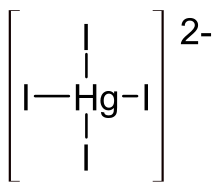- Potassium tetraiodomercurate(II)
-
Potassium tetraiodomercurate(II) potassium tetraiodomercurate(II)Other namesmercuric potassium iodide,
Nessler's reagent (principal component)Identifiers CAS number 7783-33-7 UN number 3287 Properties Molecular formula HgI4K2 Molar mass 786.4 g mol−1 Density 1.16 g/cm3 Hazards MSDS External MSDS for Nessler's reagent Related compounds Other anions Mercury(II) iodide  tetraiodomercurate(II) (verify) (what is:
tetraiodomercurate(II) (verify) (what is:  /
/ ?)
?)
Except where noted otherwise, data are given for materials in their standard state (at 25 °C, 100 kPa)Infobox references Potassium tetraiodomercurate(II) is an inorganic compound containing potassium cations and the tetraiodomercurate(II) complex anion. It is mainly used as Neßler's reagent, a 0.09 mol/L solution of potassium tetraiodomercurate(II) (K2[HgI4]) in 2.5 mol/L potassium hydroxide, used to detect ammonia.
Contents
Nessler's reagent
Named after Julius Neßler, when this solution gives a yellow coloration, it indicates the presence of ammonia: at higher concentrations, a brown precipitate may form. The sensitivity as a spot test is about 0.3 μg NH3 in 2 μL.[citation needed]
- NH4+ + 2[HgI4]2− + 4OH− → HgO·Hg(NH2)I + 7I− + 3H2O
Nessler's reagent is generally prepared from potassium iodide and mercury(II) chloride. A hot concentrated solution of mercury(II) chloride is added to concentrated solution of potassium iodide, until the precipitate of mercury(II) iodide stops dissolving. The liquid is filtered, and potassium hydroxide and a further bit of mercury(II) chloride solution are added. The resulting solution is then cooled and diluted to required concentration.[1] Nessler's reagent may be used with Nessler tubes.
References
- Vogel, Arthur I.; Svehla, G. (1979), Vogel's Textbook of Macro and Semimicro Qualitative Inorganic Analysis (5th ed.), London: Longman, ISBN 0-582-44367-9
Further reading
- Mok, K. F.; McKee, V. (1990). "Structure of a dipotassium tetraiodomercurate(II) salt with dibenzo-18-crown-6". Acta Crystallographica C 46: 2078. doi:10.1107/S0108270190003742.
External links
- IARC Monograph: "Mercury and Mercury Compounds"
- National Pollutant Inventory - Mercury and compounds fact sheet
Mercury compounds Categories:- Iodides
- Potassium compounds
- Mercury compounds
- IARC Group 3 carcinogens
- Coordination compounds
- Chemical tests
Wikimedia Foundation. 2010.

